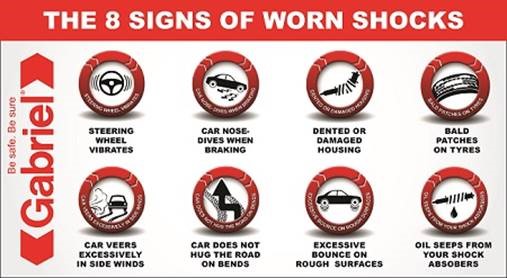With the Easter holidays upon us, checking your vehicle before going on a long trip is important. This includes your tyres and another component that people don’t often check, your shock absorbers.
People are often unsure about how to determine whether their shocks need to be replaced. Here are eight basic signs:
1. If your steering wheel vibrates, this is a possible sign that you could have worn shock absorbers..
2. Worn shocks absorbers can make your vehicle’s tyres bounce. This in turn can create bald patches on the tyres which are dangerous and will affect the performance of the tyre. Check your tyres for uneven wear and bald patches.
3. Braking with worn shocks can result in your vehicle nose-diving and will increase your braking distance considerably
4. In strong winds, it will be more difficult to control your vehicle. Your vehicle will veer in side winds – and is especially at risk on bridges, cliffs and narrow roads.
5. Your vehicle will not hug the road on bends. This can make the car difficult to control, especially at higher speeds.
6. Leaking oil is another indicator. If the shock is leaking oil you need to replace the shock immediately..
7. When driving on rough road surfaces, worn shock absorbers will allow the car’s wheels bounce giving the tyre less contact with the road surface and lower the ability to control the vehicle. Worn shocks can also place severe stress on the wheel bearings and other suspension components.
8. Dented or damaged shocks can be caused by outside forces such as stones. This can lead to the restriction of oil between the inner and outer tubes, resulting in poor performance of the shocks. Overall, worn shocks can increase risk of an accident.
Shock absorbers are the single most overlooked safety critical part in a vehicle. Worn shocks can cause excessive spring movement of the vehicle, making the vehicle difficult to handle. This can also affect brake control, reduce the efficiency of Anti-Lock Braking Systems (ABS) and Electronic Stability Control (ESP) and cause the car to sway dangerously. Shock absorbers that are in good a condition are not only a necessity for proper car handling, but become especially important in emergency manoeuvres. Worn shocks won’t keep your wheels in contact with the road, no matter how new your tyres are. Even cars with good tyres, worn shocks can cause the tyres to bounce and loose grip.
Shocks do wear out, but this is normally a gradual process and they rarely fail completely. There are between 30 and 40 precision engineered parts inside a shock which includes valves, valve seats and springs, pistons, a piston rod and a number of high-precision rubbers and seals.
Gas shocks are 95% filled with oil. Oil is what controls the movement of the piston. The gas is used to give a faster reaction time, thus forcing the wheel back down when there is movement.
Shocks are not as expensive as you think. A new set of shocks for most vehicles is generally cheaper than a set of tyres. Another consequence of not changing your shocks could lead to other damage to your vehicles suspension resulting in additional costs.
In terms of quality, Gabriel will not compromise on component quality and manufactures to OE equivalent standards (Original Equipment). Gabriel South Africa is ISO 14001, ISO9000 rated. ISO is an international quality management system that rates and monitors business processes and continually reviews these in order to facilitate continual improvement.
